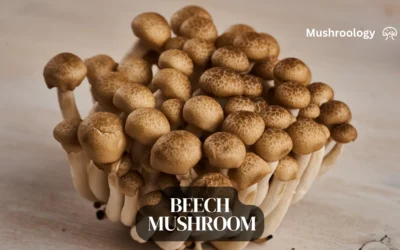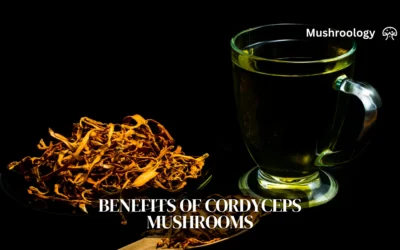The Shaggy Mane Mushroom, also known as Lawyer’s Wig, Ink Cap, or Coprinus comatus, is an edible mushroom with a striking shaggy appearance. This mushroom is very tasty with a rich umami flavour. Shaggy Manes grow naturally in grasslands, but they can also thrive when cultivated at home both indoors and outdoors.
One of the most intriguing aspects of Coprinus Comatus is its self-digestion process, known as autodigestion or deliquescence. After the mushroom’s spores mature, the cap of Coprinus comatus begins to digest itself from the bottom up, turning into a black, inky substance. This liquidation process helps in the dispersal of its spores. The “ink” produced was historically used as writing ink, giving this mushroom an interesting link to human use. Moreover, this autodigestion process occurs rapidly, often within a few hours, which means these mushrooms have a very short lifespan after they mature.

This article provides step-by-step instructions for beginners on how to grow Shaggy Mane mushrooms using ready-made grow kits or homemade substrates.
Overview of Growing Conditions
Shaggy Mane mushrooms require:
- Temperatures: 50-68°F (10-20°C)
- Humidity: 40-60%
- Light: Indirect sunlight
Maintaining the ideal temperature and humidity range is vital for a successful crop. Failing to do so can lead to issues like stunted growth.
Growing Shaggy Manes Indoors
Two main methods for growing Shaggy Mane mushrooms indoors are using a grow kit or inoculating your own substrate.
Using a Grow Kit
Grow kits offer a simple way to get started with mushroom growing. The substrate in these kits comes pre-inoculated with mushroom mycelium.
Follow these basic steps when fruiting a Shaggy Mane grow kit:
- Select an indoor area maintaining 50-68°F (10-20°C) out of direct sunlight.
- Carefully open the grow kit following any specific instructions.
- Mist the inside of the bag 1-2 times per day to sustain 40-60% humidity.
- Harvest mushrooms when the caps first start expanding but before they flatten completely.
- Store freshly picked mushrooms in paper bags in the refrigerator for up to 14 days.
Using Your Substrate
You can also grow Shaggy Manes by inoculating your own sterilized substrate, like straw or sawdust. This involves a few more steps but allows you to get more growth cycles from the substrate.
Here is the basic process:
- Pasteurize straw or hardwood sawdust substrate to kill contaminants.
- Mix in pre-colonized mushroom grain spawn.
- Allow spawn to colonize the substrate fully (10-28 days).
- Initiate fruiting by exposing the substrate to light and proper humidity levels.
- Harvest mushrooms at their peak.
- Repeat for 1-2 additional flushes.
Growing Shaggy Manes Outdoors
Shaggy Mane mushrooms grow well outdoors in grasslands, lawns, or gardens. Spores can be collected and used to inoculate substrate in mushroom beds or pots.
Follow these basic outdoor cultivation steps:
- Prepare substrate of composted grass clippings, straw, or wood chips.
- Mix in collected Shaggy Mane spores.
- Keep substrate moist and shaded as it colonizes over several weeks.
- Expose fully colonized substrate to indirect light to trigger fruiting.
- Mist daily and harvest mushrooms as they mature.
How to preserve freshly harvested shaggy mane mushrooms:
- Drying/Dehydrating: Slice shaggy manes about 3/8 inch thick and dehydrate in a food dehydrator or other warm, well-ventilated area. This method causes some loss of flavour but allows long-term storage.
- Pickling: Use standard pickling recipes and techniques to pickle whole, small, shaggy manes or halves/quarters of larger ones. Pickling alters the mushrooms’ natural flavor.
- Freezing: Blanch raw shaggy manes briefly in boiling water, chill in ice water, drain, and freeze in airtight bags from which air has been squeezed out. It is best used later in soups or sauces as the texture changes with freezing.
- Sauteing then Freezing: Saute fresh shaggy manes into a skillet until the liquid evaporates. Cool completely, then freeze sauteed mushrooms in single portions. Said to preserve delicate flavour best.
- Refrigerating in Water: Place fresh shaggy manes in cold water in a sealed container in the fridge to slow deterioration. Works for 1-2 days.
With their unique appearance and appealing flavor, Shaggy Mane mushrooms can be easily grown at home. Just maintain the ideal humidity, temperatures, and substrate conditions to produce a successful mushroom harvest!
FAQ
What is the ideal temperature for fruiting Shaggy Mane mushrooms?
The ideal temperature range for fruiting Shaggy Mane mushrooms is 50-68°F (10-20°C).
What level of humidity is best for Shaggy Manes to grow properly?
Shaggy Manes grow best at a humidity level of 40-60%.
How long does it take for Shaggy Mane spawn to fully colonize the mushroom substrate?
It takes approximately 3-8 weeks for Shaggy Mane mushroom spawn to fully colonize the substrate.
Can Shaggy Mane mushrooms be grown in direct sunlight?
No, Shaggy Manes require indirect natural light or artificial lighting. Direct sunlight can dry out the mushrooms.
What depth should the Shaggy Mane mushroom substrate layer be?
The substrate layer should be 2-4 inches (5-10 cm) thick to grow Shaggy Mane mushrooms.
What is the average yield per flush when cultivating Shaggy Manes? When growing Shaggy Manes, expect approximately 0.25-1 lb (100-500 grams) fresh weight per flush.
How often should humidity levels be checked when fruiting Shaggy Manes?
Check humidity levels 1-2 times daily when fruiting Shaggy Mane mushrooms.
Does growing Shaggy Mane mushrooms require any special equipment?
Basic home growing requires no special equipment beyond a humidity gauge/hygrometer.
Is it possible to reuse spent Shaggy Mane substrate?
Yes, Shaggy Mane substrate can produce around 2-3 flushes over 6-8 weeks before needing replacement.
What types of materials can be used as a substrate for cultivating Shaggy Manes?
Straw, sawdust, wood chips, and composted grass clippings can all be used.





